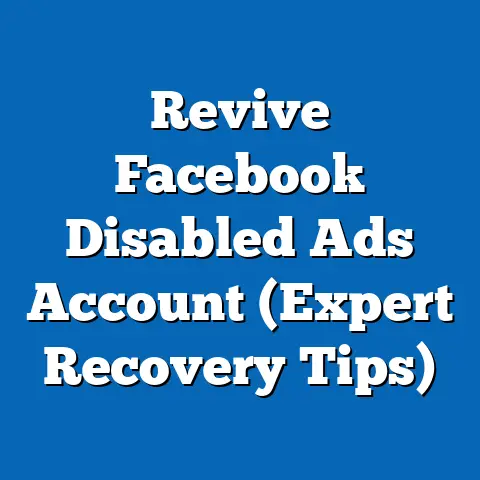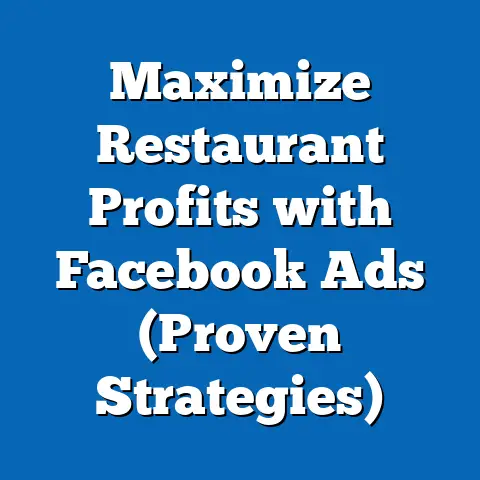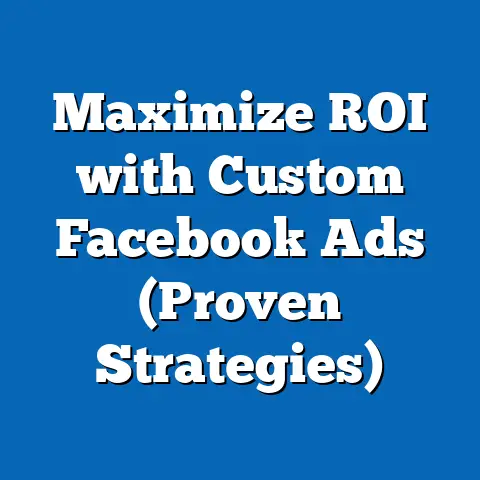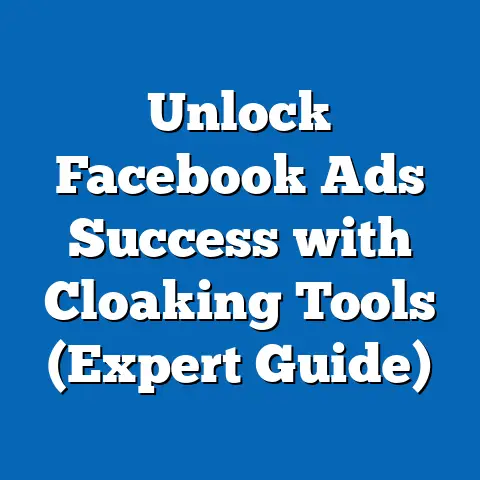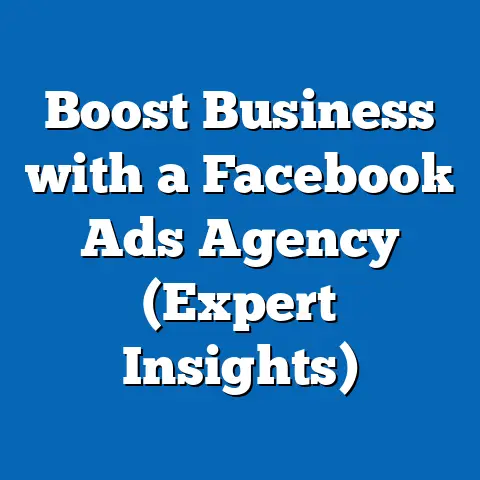Master Budget: How Much to Spend on Facebook Ads (Expert Guide)
The world of digital advertising is a constantly shifting landscape, but one thing remains consistent: Facebook ads are a powerful tool for businesses of all sizes. I’ve seen firsthand how a well-crafted Facebook ad campaign can skyrocket brand awareness, generate leads, and drive sales. However, simply throwing money at Facebook isn’t a recipe for success. It requires a strategic approach, and at the heart of that strategy lies your advertising budget.
The Facebook advertising platform has undergone a massive transformation in recent years. Algorithms are constantly evolving, audience targeting is becoming more sophisticated, and new ad formats are emerging at a rapid pace. This means that the old “set it and forget it” approach to budgeting is no longer viable. You need a “master budget” – a comprehensive, adaptable plan that aligns your spending with your business goals and market realities.
In this guide, I’ll walk you through the process of creating a master budget for your Facebook ads. I’ll cover everything from understanding the Facebook ads landscape to setting realistic goals, crafting a detailed budget plan, and leveraging the right tools and resources. By the end of this article, you’ll have the knowledge and tools you need to make informed decisions about your Facebook ad spend and maximize your return on investment.
Key Takeaways:
- Facebook ads are a powerful tool, but require a strategic budget. A well-planned budget is crucial for maximizing your ROI.
- Understand the Facebook ads landscape. Different ad types, audience demographics, and industry competition all influence costs.
- Set clear advertising goals. Your goals will directly impact your budget allocation.
- Craft a detailed master budget. This includes overall marketing budget allocation, percentage dedicated to Facebook ads, and monthly versus seasonal considerations.
- Leverage the right tools and resources. Facebook Ads Manager and third-party analytics tools can help you track performance and optimize spending.
Section 1: Understanding the Facebook Ads Landscape
Before diving into the specifics of budgeting, it’s crucial to understand the current Facebook ads landscape. This involves familiarizing yourself with the different ad types, understanding demographic trends, and analyzing the competitive environment.
Types of Facebook Ads and Their Costs
Facebook offers a diverse range of ad formats, each designed to achieve different marketing objectives. Understanding these formats and their associated costs is the first step in creating your master budget.
- Image Ads: These are the simplest form of Facebook ads, consisting of a single image and accompanying text. They’re great for brand awareness and showcasing products. Generally, image ads are among the most cost-effective, especially when targeting broad audiences.
- Video Ads: Video ads are more engaging than image ads and are ideal for storytelling and demonstrating product features. I’ve found that shorter, attention-grabbing videos tend to perform best. Video ads can be more expensive than image ads, particularly if you’re targeting a highly specific audience or using premium video placements.
- Carousel Ads: Carousel ads allow you to showcase multiple images or videos in a single ad unit. This is perfect for highlighting different aspects of a product or service. Carousel ads tend to be more effective for driving conversions, but they can also be more expensive due to the increased complexity of the ad design.
- Collection Ads: Collection ads are designed for e-commerce businesses and allow users to browse products directly from the ad. These ads typically feature a cover image or video, followed by a selection of related products. Collection ads are highly effective for driving sales, but they require a well-structured product catalog and can be more expensive to run.
- Lead Ads: Lead ads are specifically designed to generate leads directly on Facebook. They feature a built-in form that users can fill out without leaving the platform. Lead ads are great for collecting contact information and building your email list. I’ve seen businesses achieve significant lead generation results with these ads, but they require careful targeting and compelling ad copy.
Cost Factors:
The cost of each ad type varies depending on several factors, including:
- Target Audience: Targeting a highly specific audience will typically result in higher costs.
- Ad Placement: Ads placed in high-visibility locations, such as the Facebook News Feed, tend to be more expensive.
- Bidding Strategy: Your bidding strategy (e.g., cost per click, cost per impression) will influence your overall costs.
- Ad Quality: High-quality ads that are relevant to your target audience will generally perform better and cost less.
- Competition: The level of competition in your industry will affect the cost of your ads.
Demographic Trends of Facebook Users
Understanding the demographic trends of Facebook users is crucial for effective targeting and budgeting. While Facebook boasts a massive user base, it’s important to know who’s actually using the platform and how they’re engaging with ads.
- Age: While Facebook is popular across all age groups, the platform is particularly strong among users aged 25-54. If your target audience falls within this age range, Facebook is likely a good fit for your advertising efforts.
- Gender: Facebook has a relatively balanced gender distribution, with slightly more female users than male users. However, the gender breakdown can vary depending on the specific interests and demographics you’re targeting.
- Location: Facebook is a global platform, but the user base is concentrated in certain regions, such as North America, Europe, and Asia. If you’re targeting a specific geographic location, you’ll need to consider the cost of advertising in that region.
- Interests: Facebook’s interest-based targeting allows you to reach users based on their hobbies, passions, and affinities. Understanding the interests of your target audience is crucial for creating relevant and engaging ads.
- Behavior: Facebook tracks user behavior on and off the platform, allowing you to target users based on their purchase history, online activity, and other behavioral traits. This can be incredibly powerful for reaching the right people with the right message.
Analyzing the Competitive Landscape
Before launching your Facebook ad campaign, it’s important to analyze the competitive landscape. This involves understanding how your competitors are using Facebook ads and identifying opportunities to differentiate yourself.
- Identify Your Competitors: Start by identifying your main competitors in the Facebook advertising space. This can be done by searching for relevant keywords and seeing which businesses are advertising in your niche.
- Analyze Their Ads: Once you’ve identified your competitors, take a close look at their ads. What types of ads are they running? What messaging are they using? Who are they targeting?
- Assess Their Budget: While you can’t know exactly how much your competitors are spending on Facebook ads, you can get a sense of their budget by looking at the frequency and reach of their ads. Are they running ads constantly, or only during certain periods? Are their ads reaching a large audience, or a smaller, more targeted group?
- Identify Opportunities: By analyzing the competitive landscape, you can identify opportunities to differentiate yourself and stand out from the crowd. This might involve targeting a different audience, using a different ad format, or crafting a more compelling message.
Facebook Ad Performance Metrics
Understanding Facebook ad performance metrics is crucial for tracking your progress and optimizing your campaigns. Here are some of the most important metrics to monitor:
- Click-Through Rate (CTR): This measures the percentage of people who see your ad and click on it. A high CTR indicates that your ad is relevant and engaging to your target audience.
- Conversion Rate: This measures the percentage of people who click on your ad and complete a desired action, such as making a purchase or filling out a form. A high conversion rate indicates that your ad is effectively driving results.
- Cost Per Click (CPC): This measures the average cost you pay each time someone clicks on your ad. A low CPC indicates that you’re getting good value for your ad spend.
- Cost Per Impression (CPM): This measures the average cost you pay for every 1,000 impressions of your ad. CPM is a good metric for measuring brand awareness and reach.
- Return on Ad Spend (ROAS): This measures the amount of revenue you generate for every dollar you spend on advertising. A high ROAS indicates that your ad campaigns are profitable.
Industry Benchmarks:
While the ideal values for these metrics will vary depending on your industry and campaign goals, here are some general benchmarks to keep in mind:
- Average CTR: 0.9%
- Average Conversion Rate: 9.21%
- Average CPC: \$0.97
- Average CPM: \$7.19
- Average ROAS: 2-3x
Takeaway: Understanding the Facebook ads landscape, including ad types, demographic trends, competitive environment, and performance metrics, is crucial for creating a successful Facebook ad campaign and developing a realistic master budget.
Section 2: Determining Your Advertising Goals
Before you even think about numbers, you need to know why you’re advertising on Facebook. What do you hope to achieve? Your advertising goals will directly influence your budget allocation.
Importance of Setting Clear Objectives
Setting clear objectives for your Facebook advertising campaigns is essential for several reasons:
- Focus: Clear objectives provide focus and direction for your campaigns, ensuring that your efforts are aligned with your overall business goals.
- Measurement: Clear objectives allow you to measure the success of your campaigns and track your progress over time.
- Optimization: Clear objectives enable you to optimize your campaigns for maximum impact, ensuring that you’re getting the best possible return on your investment.
- Accountability: Clear objectives create accountability, ensuring that you and your team are responsible for achieving the desired results.
Different Goals and Budget Allocation
Different advertising goals require different budget allocations. For example, a brand awareness campaign will typically require a larger budget than a lead generation campaign, due to the broader reach and lower conversion rates.
Here’s a breakdown of some common advertising goals and their associated budget ranges:
- Brand Awareness: The goal of a brand awareness campaign is to increase awareness of your brand among your target audience. These campaigns typically focus on reach and frequency, aiming to get your brand in front of as many people as possible. Budget Range: \$5-\$10 CPM
- Lead Generation: The goal of a lead generation campaign is to collect leads from potential customers. These campaigns typically focus on driving traffic to a landing page or using lead ads to collect contact information directly on Facebook. Budget Range: \$5-\$20 per lead
- Sales Conversions: The goal of a sales conversion campaign is to drive sales of your products or services. These campaigns typically focus on targeting users who are likely to make a purchase and using persuasive ad copy and visuals to encourage them to take action. Budget Range: 5-20% of product cost per acquisition
- Website Traffic: The goal of a website traffic campaign is to drive traffic to your website. These campaigns typically focus on targeting users who are interested in your products or services and using compelling ad copy and visuals to encourage them to click through to your site. Budget Range: \$0.50-\$2 per click
- App Installs: The goal of an app install campaign is to drive downloads of your mobile app. These campaigns typically focus on targeting users who are likely to be interested in your app and using persuasive ad copy and visuals to encourage them to download it. Budget Range: \$1-\$5 per install
Industry Examples:
The average budget ranges for these goals can vary depending on your industry. For example, a brand awareness campaign for a small local business might have a budget of \$500-\$1,000 per month, while a sales conversion campaign for a large e-commerce company might have a budget of \$10,000-\$50,000 per month.
Measuring Success and Adjusting Goals
Once you’ve launched your Facebook ad campaign, it’s important to track your progress and measure your success. This involves monitoring your key performance indicators (KPIs) and comparing them to your initial goals.
If you’re not achieving your goals, it’s important to adjust your strategy. This might involve changing your targeting, ad creative, or bidding strategy. It might also involve reevaluating your goals and setting more realistic expectations.
Key Performance Indicators (KPIs):
Here are some key performance indicators (KPIs) to monitor:
- Reach: The number of unique users who have seen your ad.
- Impressions: The number of times your ad has been displayed.
- Clicks: The number of times users have clicked on your ad.
- Conversions: The number of times users have completed a desired action, such as making a purchase or filling out a form.
- Cost Per Result: The average cost you pay for each desired result, such as a click, conversion, or lead.
- Return on Ad Spend (ROAS): The amount of revenue you generate for every dollar you spend on advertising.
Takeaway: Setting clear advertising goals is crucial for effective budgeting and campaign optimization. Different goals require different budget allocations, and it’s important to track your progress and adjust your strategy as needed.
Section 3: Crafting Your Master Budget
Now that you understand the Facebook ads landscape and have defined your advertising goals, it’s time to craft your master budget. This involves outlining the key components of your budget, understanding the importance of testing and iteration, and creating a detailed budget plan.
Key Components of a Master Budget
A master budget for Facebook ads should include the following key components:
- Overall Marketing Budget Allocation: Determine how much of your overall marketing budget you’re willing to allocate to Facebook ads. This will depend on your business goals, target audience, and the effectiveness of other marketing channels.
- Percentage Dedicated to Facebook Ads: Decide what percentage of your allocated marketing budget you’ll dedicate to Facebook ads. This will depend on the potential ROI of Facebook ads compared to other advertising channels.
- Monthly vs. Seasonal Budgeting: Consider whether you’ll have a consistent monthly budget or a seasonal budget that fluctuates based on your business needs. For example, if you’re an e-commerce business, you might allocate a larger budget to Facebook ads during the holiday season.
- Campaign Budget Optimization (CBO): CBO allows Facebook to automatically distribute your budget across your ad sets to get the best overall results. This can be a great way to optimize your budget and maximize your ROI.
- Ad Set Budgets: If you’re not using CBO, you’ll need to set individual budgets for each of your ad sets. This will allow you to control how much you’re spending on each audience and ad creative.
- Bidding Strategy: Choose a bidding strategy that aligns with your advertising goals. For example, if you’re focused on driving conversions, you might choose a conversion-based bidding strategy.
- Ad Creative Costs: Factor in the costs of creating your ad creative, including design fees, copywriting fees, and video production costs.
- Testing and Optimization Budget: Allocate a portion of your budget to testing and optimization. This will allow you to experiment with different targeting options, ad creative, and bidding strategies to improve your campaign performance.
Importance of Testing and Iteration
Testing and iteration are crucial for successful Facebook advertising. The Facebook algorithm is constantly changing, and what worked yesterday might not work today. You need to be constantly testing new ideas and iterating on your existing campaigns to stay ahead of the curve.
- A/B Testing: A/B testing involves creating two versions of an ad and testing them against each other to see which one performs better. This can be used to test different headlines, images, ad copy, or call-to-actions.
- Audience Testing: Audience testing involves targeting different audiences with your ads to see which one is most receptive. This can be used to test different demographics, interests, or behaviors.
- Placement Testing: Placement testing involves testing different ad placements to see which one performs best. This can be used to test different placements within Facebook, as well as placements on Instagram and other platforms.
- Budget Allocation for Testing: Allocate a portion of your budget specifically for testing and optimization. This will allow you to experiment with different ideas without risking your entire budget.
Step-by-Step Guide to Creating a Detailed Budget Plan
Here’s a step-by-step guide to creating a detailed budget plan for your Facebook ads:
- Define Your Goals: Start by clearly defining your advertising goals. What do you hope to achieve with your Facebook ads?
- Research Your Audience: Research your target audience to understand their demographics, interests, and behaviors.
- Analyze Your Competition: Analyze your competition to see how they’re using Facebook ads and identify opportunities to differentiate yourself.
- Choose Your Ad Formats: Choose the ad formats that are most likely to achieve your advertising goals and resonate with your target audience.
- Set Your Bidding Strategy: Choose a bidding strategy that aligns with your advertising goals and budget.
- Allocate Your Budget: Allocate your budget across your campaigns, ad sets, and ad creative based on your goals and research.
- Track Your Results: Track your results closely and make adjustments as needed.
- Test and Optimize: Continuously test and optimize your campaigns to improve your performance.
- Document Everything: Document your budget plan, including your goals, research, assumptions, and results.
- Review and Revise: Review and revise your budget plan regularly to ensure that it’s still aligned with your business goals and market conditions.
Tools and Resources:
- Facebook Ads Manager: Facebook Ads Manager is the primary tool for managing your Facebook ad campaigns. It provides detailed insights into your performance and allows you to make adjustments to your budget and targeting.
- Third-Party Analytics Tools: Third-party analytics tools, such as Google Analytics and Adobe Analytics, can provide additional insights into your website traffic and conversions.
- Budget Calculators: Budget calculators can help you estimate the cost of your Facebook ad campaigns based on your goals and target audience.
Takeaway: Crafting a detailed master budget is crucial for maximizing the effectiveness of your Facebook ads. This involves outlining the key components of your budget, understanding the importance of testing and iteration, and creating a detailed budget plan.
Section 4: Tools and Resources for Budgeting
Managing a Facebook ad budget effectively requires the right tools and resources. These tools can help you track ad performance, optimize spending, and make data-driven decisions.
Essential Tools for Managing Facebook Ad Budgets
- Facebook Ads Manager: This is the core platform for creating, managing, and analyzing your Facebook ad campaigns. Within Ads Manager, you can set daily or lifetime budgets, monitor ad spend, and track key metrics like impressions, clicks, and conversions. I rely heavily on Ads Manager to get a real-time view of how my campaigns are performing.
- Facebook Business Suite: This platform consolidates various Facebook business tools, including Ads Manager, into a single interface. It allows you to manage your Facebook and Instagram accounts, schedule posts, and track overall business performance.
- Google Analytics: Integrating Google Analytics with your Facebook ads allows you to track website traffic and conversions that originate from your Facebook campaigns. This provides a more holistic view of your ad performance and helps you understand how your ads are contributing to your overall business goals.
- Third-Party Analytics Tools: Several third-party analytics tools, such as AdEspresso, Hootsuite Ads, and SocialPilot, offer advanced features for managing and optimizing Facebook ad campaigns. These tools can provide deeper insights into your data and automate certain tasks, such as A/B testing and budget optimization.
- Budget Calculators: Online budget calculators can help you estimate the cost of your Facebook ad campaigns based on your goals, target audience, and industry benchmarks. These calculators can be a useful starting point for creating your master budget.
Tracking Ad Performance, Spending, and ROI
- Ad Spend: Regularly monitor your ad spend in Ads Manager to ensure that you’re staying within your budget. Set up automated alerts to notify you when your spend reaches a certain threshold.
- Key Metrics: Track key metrics like impressions, clicks, CTR, conversions, and ROAS to assess the performance of your campaigns. Use these metrics to identify areas for improvement and optimize your ads accordingly.
- Attribution: Use Facebook’s attribution tools to understand which ads and campaigns are driving the most valuable conversions. This will help you allocate your budget to the most effective campaigns.
- Reporting: Generate regular reports in Ads Manager to track your progress over time. Use these reports to identify trends, patterns, and opportunities for improvement.
Utilizing Facebook’s Built-In Features for Budget Management
- Campaign Budget Optimization (CBO): CBO allows Facebook to automatically distribute your budget across your ad sets to get the best overall results. This can be a great way to optimize your budget and maximize your ROI. To use CBO, simply select “Campaign Budget Optimization” when creating a new campaign and set your overall campaign budget.
- Ad Set Budgets: If you’re not using CBO, you can set individual budgets for each of your ad sets. This allows you to control how much you’re spending on each audience and ad creative. To set an ad set budget, simply select “Ad Set Budget” when creating a new ad set and enter your desired budget.
- Scheduled Budgets: You can schedule your budgets to run during specific times or days of the week. This can be useful for targeting audiences when they’re most active or for running ads during peak sales periods. To schedule a budget, simply select “Scheduled Budget” when creating a new campaign or ad set and enter your desired start and end dates.
- Budget Rules: You can set up automated rules to adjust your budgets based on certain performance criteria. For example, you can set a rule to automatically increase your budget if your ads are performing well or to decrease your budget if your ads are underperforming. To set up a budget rule, simply go to the “Automated Rules” section in Ads Manager and create a new rule.
Takeaway: The right tools and resources can significantly improve your ability to manage your Facebook ad budget effectively. By leveraging these tools and utilizing Facebook’s built-in features, you can track your performance, optimize your spending, and maximize your ROI.
Section 5: Case Studies and Real-World Examples
To illustrate the principles of effective Facebook ad budgeting, let’s examine a few case studies of businesses that have successfully managed their ad spend and achieved significant results.
Case Study 1: E-commerce Startup Driving Sales
- Business: A small e-commerce startup selling handmade jewelry.
- Goal: Drive sales of their products and increase brand awareness.
- Strategy: The startup allocated 60% of their marketing budget to Facebook ads, focusing on targeting users with interests in fashion, jewelry, and handmade crafts. They used a combination of image ads, carousel ads, and video ads to showcase their products and tell their brand story.
- Budget: \$2,000 per month.
- Results: Within three months, the startup saw a 300% increase in sales and a 200% increase in website traffic. They also gained a significant number of new followers on Facebook and Instagram.
- Lessons Learned: This case study demonstrates the power of targeted advertising and compelling ad creative. By focusing on users with relevant interests and using a variety of ad formats, the startup was able to drive significant sales and increase brand awareness.
Case Study 2: Local Restaurant Generating Leads
- Business: A local restaurant looking to generate leads and increase reservations.
- Goal: Generate leads from potential customers and increase online reservations.
- Strategy: The restaurant allocated 40% of their marketing budget to Facebook ads, focusing on targeting users within a 5-mile radius of their location. They used lead ads to collect contact information from potential customers and offered a special discount for those who signed up.
- Budget: \$1,000 per month.
- Results: Within two months, the restaurant generated over 500 leads and saw a 50% increase in online reservations. They also saw a significant increase in foot traffic to their restaurant.
- Lessons Learned: This case study demonstrates the effectiveness of lead ads for generating leads from local customers. By offering a special discount and targeting users within a specific geographic area, the restaurant was able to drive significant results.
Case Study 3: Software Company Increasing Brand Awareness
- Business: A software company looking to increase brand awareness and generate leads.
- Goal: Increase brand awareness among their target audience and generate leads for their sales team.
- Strategy: The software company allocated 30% of their marketing budget to Facebook ads, focusing on targeting users with interests in technology, software, and business. They used a combination of video ads and article ads to share valuable content and position themselves as thought leaders in their industry.
- Budget: \$5,000 per month.
- Results: Within four months, the software company saw a 150% increase in website traffic and a 100% increase in leads. They also saw a significant increase in engagement on their Facebook page.
- Lessons Learned: This case study demonstrates the power of content marketing for increasing brand awareness and generating leads. By sharing valuable content and positioning themselves as thought leaders, the software company was able to attract a large audience and drive significant results.
Best Practices:
Based on these case studies, here are some best practices for managing your Facebook ad budget:
- Set Clear Goals: Define your advertising goals and track your progress over time.
- Research Your Audience: Understand your target audience and target your ads accordingly.
- Analyze Your Competition: Analyze your competition and identify opportunities to differentiate yourself.
- Choose the Right Ad Formats: Choose the ad formats that are most likely to achieve your goals.
- Test and Optimize: Continuously test and optimize your campaigns to improve your performance.
- Track Your Results: Track your results closely and make adjustments as needed.
- Document Everything: Document your budget plan, assumptions, and results.
- Review and Revise: Review and revise your budget plan regularly to ensure that it’s still aligned with your business goals.
Takeaway: These case studies demonstrate the importance of effective Facebook ad budgeting and provide valuable insights into how businesses can achieve significant results by managing their ad spend strategically.
Conclusion
Creating a master budget for your Facebook ads is not just about crunching numbers; it’s about aligning your advertising efforts with your overall business goals. By understanding the Facebook ads landscape, setting clear objectives, crafting a detailed budget plan, and leveraging the right tools and resources, you can maximize the effectiveness of your campaigns and achieve significant results.
Remember that Facebook advertising is a constantly evolving landscape. Algorithms change, new ad formats emerge, and consumer behavior shifts. This means that your budget plan should be a living document that you review and revise regularly. Stay flexible, be willing to experiment, and always focus on delivering value to your target audience.
Ultimately, the key to successful Facebook advertising is a data-driven approach. Track your results closely, analyze your performance, and make adjustments as needed. By continuously testing, optimizing, and iterating on your campaigns, you can achieve your advertising goals and drive significant growth for your business.
Now, I encourage you to take action. Start by assessing your current Facebook advertising efforts and identifying areas for improvement. Create a detailed master budget that aligns with your business goals and leverage the tools and resources discussed in this guide. And most importantly, don’t be afraid to experiment and try new things.
I’d love to hear about your own experiences with Facebook ad budgeting. Share your thoughts, tips, and challenges in the comments below. Let’s learn from each other and build a community of successful Facebook advertisers.

